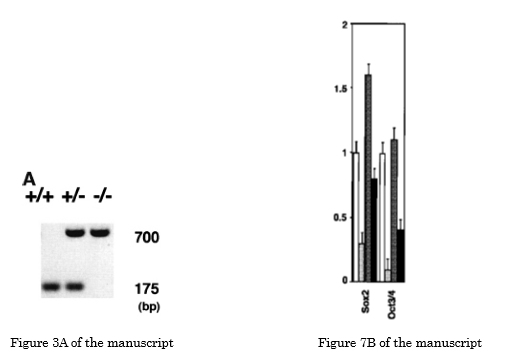
News & Events
News & Events
News
April 30, 2014
About a paper published in The EMBO Journal by Prof. Yamanaka and his colleagues
1. Background
Professor Shinya Yamanaka of Kyoto University's Center for iPS Cell Research and Application (CiRA) has found a website on which questions are raised over graphic figures that appeared in a scientific paper published in 2000 by a research group to which the professor belonged.
In response to a request from Professor Yamanaka, CiRA has carried out an investigation to establish the facts.
2. Substance of questions raised
1) In Figure 3A of the scientific paper, which demonstrates the generation of NAT1 gene knockout (NAT1-/-) ES cells, the PCR bands are similar to the bands in adjacent lanes (NAT1+/-).
2) In Figure 7B of the scientific paper, which demonstrates reduced differentiation potential in NAT1-/-ES cells, the standard deviation values in Northern blot quantification data (amount of expression of Oct3/4 and Sox2 genes) are unnaturally close together in all samples.
Shinya Yamanaka, et al.
Essential role of NAT1/p97/DAP5 in embryonic differentiation and the retinoic acid pathway
The EMBO Journal Vol. 19 No.20 pp. 5533-5541, 2000

3. Investigation results
As NAT1-/-ES cells are in current use at CiRA, we first confirmed the reproducibility of the content of the scientific paper containing the two figures. This established that the reported content of the scientific paper was correct.
Additionally, based on an examination of Professor Yamanaka's experimental notes and other past documentation, we confirmed that the experiments referred to in the figures were carried out in or around 1998 by Professor Yamanaka and a number of co-workers. However, notes and documentation from participants other than himself were not retained by Professor Yamanaka.
Next, we investigated the two figures over which questions have been raised.
Regarding the PCR in Figure 3A of the scientific paper, the bands were similar but not identical. Even after the contrast was altered, no trace of cutting and pasting was observed. Professor Yamanaka's notes and documentation were confirmed to contain experimental data (Appendix 1 and Appendix 2) from a PCR assay carried out using the same primer as in the figure which confirmed the presence of NAT1-/-ES cells. However, the original data for the figure were not found in Professor Yamanaka's notes and documentation.
Regarding Figure 7B of the scientific paper, experimental data from Northern blot analysis of Oct3/4 gene expression were found present in Professor Yamanaka's documentation. When these data were plotted as a figure, they indicated, as in Figure 7B of the scientific paper, that the decrease in the amount of Oct3/4 expression in NAT1-/-ES cells was suppressed under conditions stimulating differentiation (Appendix 3). However, since the mean values and the standard deviation value differed from those in Figure 7B of the paper, these did not appear to be the original data.
4. Response
The investigation established beyond doubt that the series of experiments referred to in the relevant scientific paper, including those related to the two figures over which questions have been raised, were indeed carried out and that the content of the scientific paper was correct. CiRA therefore judges that no additional investigation is necessary.
NAT1-/-ES cells have been deposited at the RIKEN BioResource Center and third parties are free to undertake scientific confirmation of their properties (Appendix 4).
Nevertheless, it is regrettable that the notes and documentation from participants other than himself and the original data for figures and tables were not retained in Professor Yamanaka's safekeeping.
For reasons related to research ethics and also the need for intellectual property protection, CiRA retains and manages experimental data in-house and has put in place a system allowing it to present the relevant data in response to questions of the present kind being raised.
The investigation was conducted by an internal investigation committee comprised of Prof. Shinsuke Morisawa, a deputy director at CiRA, and two members from the International Public Communications Office.
Comment from Professor Shinya Yamanaka
The research results from the scientific paper in question have been reproduced by a number of researchers within the laboratory subsequent to their publication. Regarding the figures over which issues have been raised, I have no recollection of having undertaken any action inappropriate from the point of view of researcher ethics, and there would have been no reason to take any such action. At the time of the experiment some 15 years ago, I was not sufficiently aware of the need to retain data from all members of the research team and I recognize and regret my resulting inability to present the original data from the two figures in question.
I have learned a serious lesson from the present incident and am committed going forward to continuing efforts to ensure compliance with research ethics.






















